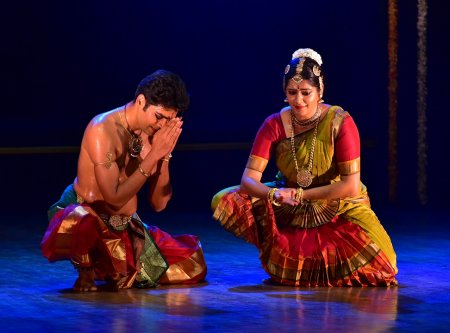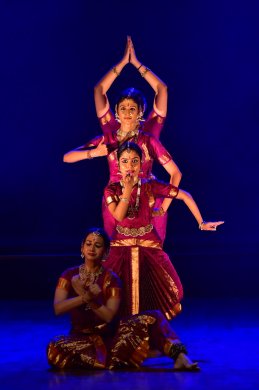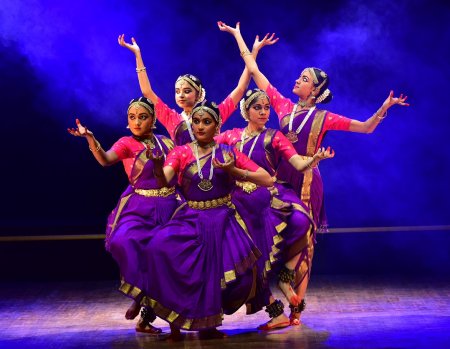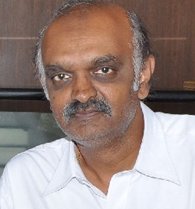
|   |

|   |
Festival of Varnams - G Ulaganathan e-mail: ulag_nath@yahoo.com Photos: Chadda & Co December 9, 2021 After more than a year, it is refreshing to see the dance scene coming back to life in this Silicon city of India. Once, not long ago, Bengaluru used to be the only city in India where there was some dance festival in some venue all through the year. And the halls were booked much in advance and one could witness all the styles of Indian classical dances here. One hopes the same scenario returns though there are devil's advocates who see more and more waves of the pandemic. One interesting festival in the last week of November was organised by the well-known dancer Janani Murali, Guru Padma Murali and Padmalaya Dance Foundation. The IDA 2021, their annual theme-based festival of dance this time was focussed on Varnam. Varnam has been an integral part of the Bharatanatyam repertoire for a long time now. The beauty, majesty and elegance of this piece have caught the imagination of several generations of artistes. What is the value of the Varnam in today's repertoire? How relevant is it to the dancer and the audience? And how are we imagining and re-imagining this piece in today's context? This year's festival tried to find answers to these vital questions and had three groups of dancers presenting three interesting varnams and exploring these issues. Though one is used to the long Varnams in solo recitals , this was an experiment worth watching .The three teams were Guru Minal Prabhu and the Mudrika Ensemble; eminent dancers Shilpa Nanjappa from Coorg and Bengaluru based dancer-teacher and choreographer Mithun Shyam, and Janani Murali with the Padmalaya Ensemble.  Mithun Shyam & Shilpa Nanjappa Shilpa and Mithun, both disciples of late Padmini Ramachandran, have been known to be experimenting with the form and taking Bharatanatyam to new frontiers. They began by exploring 'duality' - a factor which is present in every single entity. Mithun and Shilpa took on Shiva the dancing god of the cosmos, the one who balances all duality. They brilliantly combined and matched each other by presenting the physical duality through masculine and feminine energies. Then they went on to give a glimpse of emotional duality, and then explained with varied abhinaya the psychological duality which leads to vulnerability on one side and arrogance on the other. Then the duo highlighted the philosophical duality by explaining the cycle of life and death. They were able to effectively convey the message that both these sides coexist in us, steered and guided by the supreme power himself. Their dance was marked by speed, quick footwork and brilliant use of space. It was quite a treat. The varnam chosen by them was 'Aadum deivam arulvaai' in Kalyani raga. Balasubramanya Sharma provided vocal support and nattuvangam was by Pulikeshi Kasturi.  Padmalaya ensemble The Padmalaya Dance Foundation founded by Guru Padma Murali in 1985, trains dancers in Bangalore and Coimbatore. On this day the ensemble comprising Janani Murali, Associate artistic director of the foundation, along with Poshini Zunjarwad, Ranjitha Kumar and Anindita Ashok, presented a varnam in Vachaspati raga, a composition of T. Sethuraman, a beautiful song in which the sakhi is waiting for Lord Muruga. "O Sakhi, Please go and tell my Velan that in the shade of the mango trees I wait for him. I wait and wither every moment that he doesn't arrive. Has he forgotten me? How could he, for we shared embraces beyond imagination. He who rides the majestic blue peacock, he who resides in Tiruttani, seems to be playing tricks on me. I keep looking through these mirages but shrivel up. My love consumes me through the darkest hours of the night. Where is he?"...goes the song. Janani and her team gave life to this Sringara varnam with beautiful abhinaya and various bhavas. Murugan is an abstraction and personification of the 5 elements and it was a nice attempt at portraying him as a lover like Lord Krishna. There were also several other questions that the dancer raises. "Who is the Nayika who expresses her love for the Lord? Is she the devotee at the foothills of his temples? Does she assume the role of a lover or is she the one who dresses him up as an idol? He is the slayer of the demons Soorapadman who in their transient forms as a mango tree represent maya. What then is the role of the mango tree in her life? Today, he only sends the winds to embrace her .Where is the rest of him? Is he the idol on the hill or a mortal who has forgotten her?" "Velanidam poi solladi sakhiye" was a lovely interesting varnam choreographed by Padma Murali and Janani Murali and had soulful musical score and singing by Vasudha Balakrishna. Nattuvangam was by Prasanna Kumar.  Mudrika ensemble The third performance was by Mudrika ensemble of guru Minal Prabhu and the dancers were her senior students Aditi Saralaya, Amita S, Ankitha G, Nikhita S, and Mathangi Hariharan. They commenced their performance with a popular shloka "Vande Shambhum Umapathim" set to the ragam Thodi. This was followed by a varnam "Phalanetra Parvathi priya, Shankara pahimam paramesha" which glorifies Lord Shiva, the Chidambara, the Nateshwara, the one who embodies the Panchabhootas. This varnam sings the glory of Ardhanareeshwara, which stands for the indestructible force that unites together to create the entire cosmos.The union of Shiva and Parvathi after her severe penance, Shiva as the Nadapriya, the destruction of the Tripurasuras and the Samhara of Daksha by Shiva in his Kalabhairava Swaroopa are portrayed in this piece. The dancers combined well and showed glimpses of their individual talent. A little more coordination as a group and symmetry in movement would have made it a lovely piece. Composed by Balasubramanya Sharma and G Gurumurthy and choreographed by their guru Minal Prabhu, this varnam was set to Ragamalika. Janani Murali deserves a pat for coming up with this novel concept though it would be worth discussing whether a varnam should be the prerogative of a solo dancer as it is a test for his or her endurance, stamina and can be a good benchmark to assess the dancers.  G Ulaganathan is a senior dance critic based in Bengaluru. |